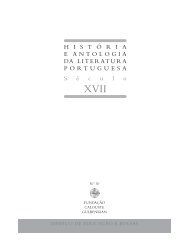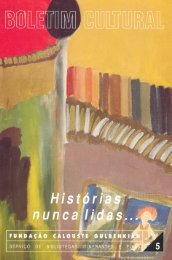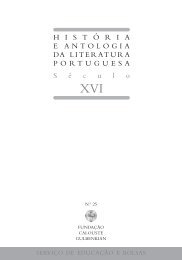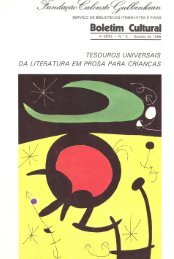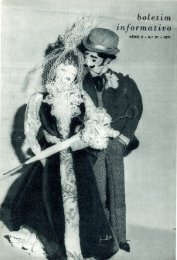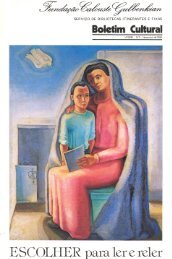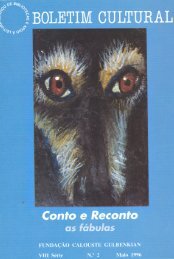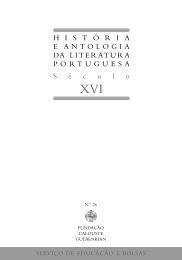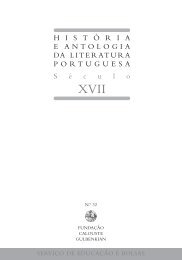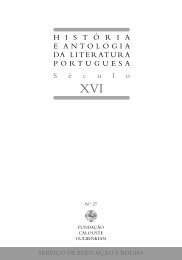Formar Leitores para Ler o Mundo - Leitura Gulbenkian - Fundação ...
Formar Leitores para Ler o Mundo - Leitura Gulbenkian - Fundação ...
Formar Leitores para Ler o Mundo - Leitura Gulbenkian - Fundação ...
You also want an ePaper? Increase the reach of your titles
YUMPU automatically turns print PDFs into web optimized ePapers that Google loves.
34<br />
were both sophisticated and varied. The paper argues, therefore, that<br />
these two qualities of picturebooks – the peritextual features and the<br />
page turns – are important for the purpose of inviting active and engaged<br />
participation on the part of readers, thus contributing both to readers’<br />
enjoyment and to their understanding/interpretation of the picturebook.<br />
Study #1<br />
Children Use Peritextual Features in Their Meaning-Making<br />
Literary critic Gérard Genette (1987/1997) uses the term «<strong>para</strong>text» to<br />
refer to these surrounding elements as well as related elements external<br />
to the book itself, such as interviews with the author and promotional<br />
materials. In his discussion of <strong>para</strong>texts, Genette distinguishes between<br />
features included within the book (the «peritext») and outside of the book<br />
(the «epitext»), and it is the peritext – what appears within the book itself<br />
– that is the focus of the present study. In picturebooks, as in other literary<br />
works, peritexts are important because they act as liminal spaces<br />
(Turner 1969) or thresholds (Genette, 1987/1997), mediating the reader’s<br />
transition from outside to inside the story world. Genette further observes<br />
that, «More than a boundary or a sealed border, the <strong>para</strong>text is, rather, a<br />
threshold, or – a word Borges used apropos of a preface – a “vestibule” that<br />
offers the world at large the possibility of either stepping inside or turning<br />
back» (pp.1-2). Derrida (1981) suggests that because of the peritext,<br />
«the text is no longer the snug airtight inside of an interiority or an identity-to-itself»<br />
(p. 35). As a «space between», the peritext is uniquely placed<br />
to draw attention to the materiality of the book and to provide a playful<br />
arena for the production of textual meaning (Higonnet, 1990), as well as<br />
presenting a rich orienting experience to the reader. While all books<br />
include some of these features, such as covers and a title page, in picturebooks<br />
all peritextual features are especially planned and designed so that<br />
there is an aesthetic coherence to the entire book (Higonnet, 1990). Thus,<br />
close examination of all of these intentionally designed features would<br />
seem to play an important role in reading picturebooks with students.<br />
Though Nikolajeva & Scott have devoted an entire chapter to this issue in<br />
their book How Picturebooks Work, few other theorists have undertaken<br />
extensive work. Still less research has considered the responses of children,<br />
though some researchers, such as Arizpe & Styles (2003) and<br />
Pantaleo (2003) have explored this issue.<br />
RESEARCH QUESTION AND METHOD<br />
The research question for this study was: In what ways do young children<br />
(age 4-7 years) respond orally to the peritextual features of picture storybooks<br />
before the story begins, in the context of whole class and small<br />
group readalouds? Data consisted of a sample of 23 transcripts of both<br />
small and large group readaloud discussions from two classrooms, drawn<br />
from 63 total transcripts from two studies of the literary responses of<br />
children (Sipe 2000; Sipe & Daley 2005). Criteria for selection of the sample<br />
consisted of the following: (1) since both studies lasted for the full<br />
school year, we skewed our selection to include more transcripts from the<br />
last half of the academic year, on the assumption that children would<br />
have become more familiar with the routines of readaloud response and<br />
would therefore demonstrate a wider repertoire of response to peritextual<br />
features; (2) we ensured that there was balance, variety, and cultural<br />
relevance in the genres of the texts read aloud, including traditional literature,<br />
fantasy, and contemporary realistic fiction; (3) we balanced the<br />
sample from the Sipe (2000) study to include roughly equal numbers of<br />
small-group and whole-class discussions; and (4) we ensured that the<br />
total number of student conversational turns in the samples from the<br />
two classrooms was roughly equal (1677 turns from the first study and<br />
1670 turns from the second), so that our results would not favor one<br />
study over the other.<br />
The first classroom (Sipe 2000) was a combined first and second grade (6<br />
and 7 year-olds) in a public school located in a working-class area of a<br />
large midwestern city, and which had a long history of using children’s<br />
literature to teach reading. The classroom teacher, a European American,<br />
had taught for six years and conducted twice-daily readalouds with the<br />
whole group of 27 children (23 European American, 3 African American,<br />
1 Native American; 15 boys and 12 girls). Data from this classroom included<br />
transcripts of 5 whole group readalouds (conducted by the teacher)<br />
and 7 small group readalouds with 5 students (conducted by Sipe). The<br />
second site (Sipe & Daley 2005) was a kindergarten classroom (4 and 5<br />
year-olds) in a large northeastern urban public school district. The classroom<br />
teacher, a European American, had taught for ten years and also<br />
read books aloud twice each day. Student enrollment varied between 20<br />
and 25 students over the course of the year; all students were African<br />
American and there was a roughly equal number of boys and girls at all<br />
times. Data from this classroom consisted of 11 transcribed whole class<br />
readalouds. Both classrooms were rich literacy environments, each with<br />
over 500 books readily available to the children in reading areas within<br />
the classrooms. In both classrooms, readalouds were conducted interactively<br />
(Barrentine 1996), with multiple opportunities for children to voice<br />
their thoughts and interpretations; as well, both teachers devoted extensive<br />
discussion to peritextual features of the picturebooks before beginning<br />
to read the story.<br />
Analysis proceeded in several stages. A first pass through the data divided<br />
each readaloud transcript into two parts: the initial portion of each<br />
readaloud discussion, where the teacher and children discussed the peri-<br />
35




